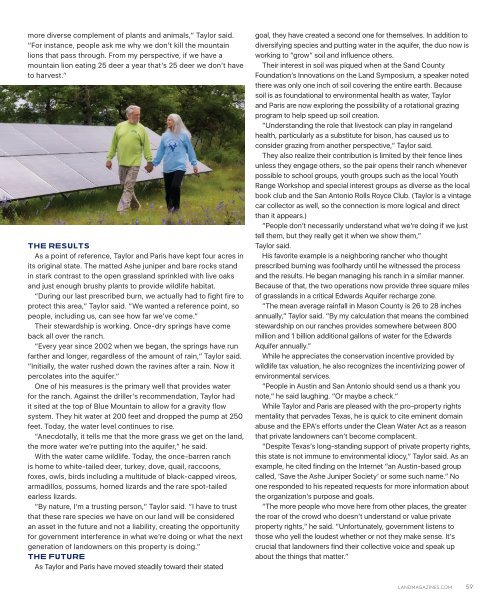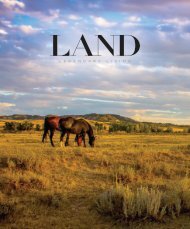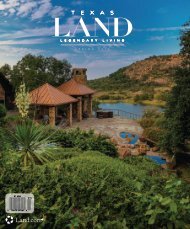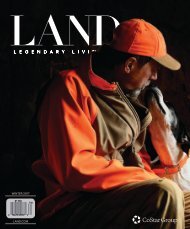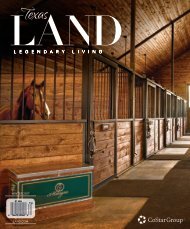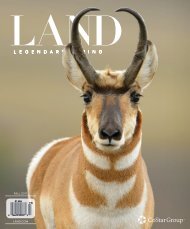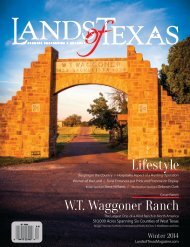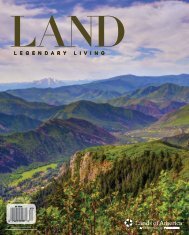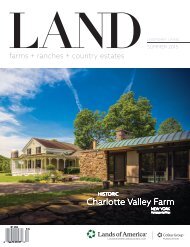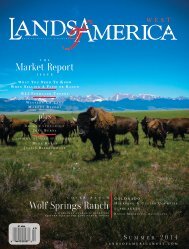You also want an ePaper? Increase the reach of your titles
YUMPU automatically turns print PDFs into web optimized ePapers that Google loves.
more diverse complement of plants and animals,” Taylor said.<br />
“For instance, people ask me why we don’t kill the mountain<br />
lions that pass through. From my perspective, if we have a<br />
mountain lion eating 25 deer a year that’s 25 deer we don’t have<br />
to harvest.”<br />
THE RESULTS<br />
As a point of reference, Taylor and Paris have kept four acres in<br />
its original state. The matted Ashe juniper and bare rocks stand<br />
in stark contrast to the open grassland sprinkled with live oaks<br />
and just enough brushy plants to provide wildlife habitat.<br />
“During our last prescribed burn, we actually had to fight fire to<br />
protect this area,” Taylor said. “We wanted a reference point, so<br />
people, including us, can see how far we’ve come.”<br />
Their stewardship is working. Once-dry springs have come<br />
back all over the ranch.<br />
“Every year since 2002 when we began, the springs have run<br />
farther and longer, regardless of the amount of rain,” Taylor said.<br />
“Initially, the water rushed down the ravines after a rain. Now it<br />
percolates into the aquifer.”<br />
One of his measures is the primary well that provides water<br />
for the ranch. Against the driller’s recommendation, Taylor had<br />
it sited at the top of Blue Mountain to allow for a gravity flow<br />
system. They hit water at 200 feet and dropped the pump at 250<br />
feet. Today, the water level continues to rise.<br />
“Anecdotally, it tells me that the more grass we get on the land,<br />
the more water we’re putting into the aquifer,” he said.<br />
With the water came wildlife. Today, the once-barren ranch<br />
is home to white-tailed deer, turkey, dove, quail, raccoons,<br />
foxes, owls, birds including a multitude of black-capped vireos,<br />
armadillos, possums, horned lizards and the rare spot-tailed<br />
earless lizards.<br />
“By nature, I’m a trusting person,” Taylor said. “I have to trust<br />
that these rare species we have on our land will be considered<br />
an asset in the future and not a liability, creating the opportunity<br />
for government interference in what we’re doing or what the next<br />
generation of landowners on this property is doing.”<br />
THE FUTURE<br />
As Taylor and Paris have moved steadily toward their stated<br />
goal, they have created a second one for themselves. In addition to<br />
diversifying species and putting water in the aquifer, the duo now is<br />
working to “grow” soil and influence others.<br />
Their interest in soil was piqued when at the Sand County<br />
Foundation’s Innovations on the Land Symposium, a speaker noted<br />
there was only one inch of soil covering the entire earth. Because<br />
soil is as foundational to environmental health as water, Taylor<br />
and Paris are now exploring the possibility of a rotational grazing<br />
program to help speed up soil creation.<br />
“Understanding the role that livestock can play in rangeland<br />
health, particularly as a substitute for bison, has caused us to<br />
consider grazing from another perspective,” Taylor said.<br />
They also realize their contribution is limited by their fence lines<br />
unless they engage others, so the pair opens their ranch whenever<br />
possible to school groups, youth groups such as the local Youth<br />
Range Workshop and special interest groups as diverse as the local<br />
book club and the San Antonio Rolls Royce Club. (Taylor is a vintage<br />
car collector as well, so the connection is more logical and direct<br />
than it appears.)<br />
“People don’t necessarily understand what we’re doing if we just<br />
tell them, but they really get it when we show them,”<br />
Taylor said.<br />
His favorite example is a neighboring rancher who thought<br />
prescribed burning was foolhardy until he witnessed the process<br />
and the results. He began managing his ranch in a similar manner.<br />
Because of that, the two operations now provide three square miles<br />
of grasslands in a critical Edwards Aquifer recharge zone.<br />
“The mean average rainfall in Mason County is 26 to 28 inches<br />
annually,” Taylor said. “By my calculation that means the combined<br />
stewardship on our ranches provides somewhere between 800<br />
million and 1 billion additional gallons of water for the Edwards<br />
Aquifer annually.”<br />
While he appreciates the conservation incentive provided by<br />
wildlife tax valuation, he also recognizes the incentivizing power of<br />
environmental services.<br />
“People in Austin and San Antonio should send us a thank you<br />
note,” he said laughing. “Or maybe a check.”<br />
While Taylor and Paris are pleased with the pro-property rights<br />
mentality that pervades Texas, he is quick to cite eminent domain<br />
abuse and the EPA’s efforts under the Clean Water Act as a reason<br />
that private landowners can’t become complacent.<br />
“Despite Texas’s long-standing support of private property rights,<br />
this state is not immune to environmental idiocy,” Taylor said. As an<br />
example, he cited finding on the Internet “an Austin-based group<br />
called, ‘Save the Ashe Juniper Society’ or some such name.” No<br />
one responded to his repeated requests for more information about<br />
the organization’s purpose and goals.<br />
“The more people who move here from other places, the greater<br />
the roar of the crowd who doesn’t understand or value private<br />
property rights,” he said. “Unfortunately, government listens to<br />
those who yell the loudest whether or not they make sense. It’s<br />
crucial that landowners find their collective voice and speak up<br />
about the things that matter.”<br />
LANDMAGAZINES.COM<br />
59


